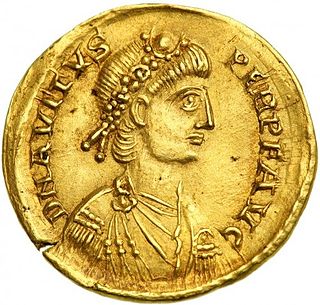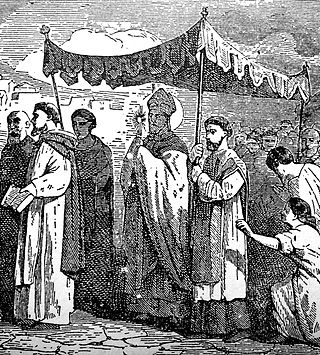Related Research Articles

Eparchius Avitus was Roman emperor of the Western Empire from July 455 to October 456. He was a senator of Gallic extraction and a high-ranking officer both in the civil and military administration, as well as Bishop of Piacenza.

Gaius Sollius Modestus Apollinaris Sidonius, better known as Sidonius Apollinaris, was a poet, diplomat, and bishop. Born into the Gallo-Roman aristocracy, he was son-in-law to Emperor Avitus and was appointed Urban prefect of Rome by Emperor Anthemius in 468. In 469 he was appointed Bishop of Clermont and he led the defence of the city from Euric, King of the Visigoths, from 473 to 475. He retained his position as bishop after the city's conquest, until his death in the 480s. He is venerated as a saint in the Catholic church, the Orthodox Church, and the True Orthodox Church, with his feast day on 21 August.

Sigismund was King of the Burgundians from 516 until his death. He was the son of king Gundobad and Caretene. He succeeded his father in 516. Sigismund and his brother Godomar were defeated in battle by Clovis's sons, and Godomar fled. Sigismund was captured by Chlodomer, King of Orléans, where he was kept as a prisoner. Later he, his wife and his children were executed. Godomar then rallied the Burgundian army and won back his kingdom.

Alcimus EcdiciusAvitus was a Latin poet and bishop of Vienne in Gaul. His fame rests in part on his poetry, but also on the role he played as secretary for the Burgundian kings.

Mamertus was the bishop of Vienne in Gaul, venerated as a saint. His primary contribution to ecclesiastical practice was the introduction of litanies prior to Ascension Day as an intercession against earthquakes and other disasters, leading to "Rogation Days." His feast day is the first of the Ice Saints.

Eucherius was a high-born and high-ranking ecclesiastic in the Christian church in Roman Gaul. He is remembered for his letters advocating extreme self-abnegation. From 439, he served as Archbishop of Lyon, and Henry Wace ranked him "the most distinguished occupant of that see" after Irenaeus. He is venerated as a saint within the Eastern Orthodox Church and the Roman Catholic Church.

February 4 - Eastern Orthodox liturgical calendar - February 6
Saint Apollinaris of Valence (453–520), born in Vienne, France, was bishop of Valence, France, at the time of the irruption of the barbarians. Valence, which was the central see of the recently founded Kingdom of the Burgundians, had been scandalized by the dissolute Bishop Maximus, and the see in consequence had been vacant for fifty years.

The Archdiocese of Lyon, formerly the Archdiocese of Lyon–Vienne–Embrun, is a Latin Church metropolitan archdiocese of the Catholic Church in France. The archbishops of Lyon are also called primates of Gaul. An archbishop is usually elevated by the pope to the rank of cardinal.
The Archbishopric of Vienne, named after its episcopal seat in Vienne in the Isère département of southern France, was a metropolitan Roman Catholic archdiocese. It is now part of the Archdiocese of Lyon.
Ruricius I was a Gallo-Roman aristocrat and bishop of Limoges from c. 485 to 510. He is one of the writers whose letters survive from late Roman Gaul, depicting the influence of the Visigoths on the Roman lifestyle. He should not be confused with his son-in-law, Saint Rusticus.
Decimus Junius Rusticus of Treves and Lyon (Lugdunum) was a Master of the Offices and the praetorian prefect of Gaul between 409 and 410 or 413. He was one of those responsible for the withdrawal from Britannia.
Saint Rusticus, the successor of Saint Lupicinus of Lyon (491-494), served as Archbishop of Lyon from 494 to April 501. Later canonized and venerated in the Catholic Church, his feast day is 25 April.

The Archdiocese of Clermont is a Latin archdiocese of the Roman Catholic Church in France. The diocese comprises the department of Puy-de-Dôme, in the Region of Auvergne. The Archbishop's seat is Clermont-Ferrand Cathedral. Throughout its history Clermont was the senior suffragan of the Archdiocese of Bourges. It became a metropolitan see itself, however, in 2002. The current archbishop is François Kalist.

August 20 - Eastern Orthodox liturgical calendar - August 22

Apollinaris was a Count of Auvergne who led a auvergnat army for the Visigoths in the Battle of Vouillé, and was bishop of Clermont for four months before his death.

Saint Pragmatius of Autun was Bishop of Autun in the 6th century. He was a friend of Sidonius Apollinaris and Avitus of Vienne, and he participated in at least one of the councils of his time. He is venerated as a saint by the Roman Catholic Church; his feast day is celebrated on 22 November.
Saint Hesychius or Isicius was a bishop of Vienne in the Dauphiné, France. He is venerated as a saint by the Catholic Church.
Julian of Vienne was a bishop of Vienne in France of the first half of the sixth century, approximately between 520 and 530. He is venerated as a saint of the Catholic Church and attended a number of early church synods.
Apollinaris was Praetorian Prefect of Gaul from May 408 or earlier until 409 AD, when he was succeeded by his friend Decimus Rusticus. He was the grandfather of Sidonius Apollinaris and was the son or grandson of another Apollinaris who was Prefect of Gaul under Constantine II between 337 and 340.
References
- ↑ "CatholicSaints.Info » Blog Archive » Archdiocese of Lyon, France" . Retrieved 2023-07-10.
- 1 2 Avitus of Vienne, (Danuta Shanzer, Ian N. Wood, trans.), Liverpool University Press, 2002, ISBN 9780853235880, p. 266
- ↑ Mélanges d'archéologie et d'Histoire, 1898, vol.18 (M. l'abbé Duchesne sur Persee. 1898).fr
Bibliography
- Bishop of Tours Gregory, Historia Francorum (The History of the Franks) (London, England: Penguin Books, Ltd., 1974).
- Sidonius Apollinaris, The Letters of Sidonius (Oxford: Clarendon, 1915) (orig.), pp. clx-clxxxiii; List of Correspondents, Notes, V.ix.1.